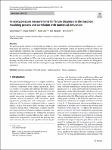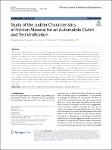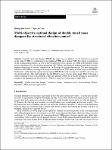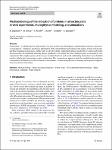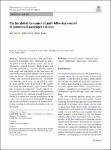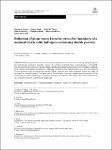Search
Author
- T. S., Amer (2)
- A., Meana-Fernández (1)
- A., Moreau (1)
- Aaliya, Sarfaraz (1)
- next >
Subject
- 17–4 PH stainless stee... (1)
- 1D-CNNs (1)
- 3CL protease (1)
- Absorbance measurement (1)
- next >
Has File(s)
- true (144)
Search Results
The pressure profile analysis for monitoring and diagnosis processing failures during an injection moulding process, such as burn marks and short shots, is a useful instrument for process and part quality control and production with zero defects and greater efficiency. Therefore, this work aims to demonstrate the in-cavity pressure monitoring feasibility for failure diagnosis and injection moulding process optimization. The methodology used to analyse the obtained pressure variation is presented. The results were correlated to the typical cavity pressure profile, which enables the acquisition of information about the process and the moulding tool. This way, it was possible to determine the origin of the defects present in the injected parts, focusing not only on the velocity to pres... |
The friction judder characteristics during clutch engagement have a significant influence on the NVH of a driveline. In this research, the judder characteristics of automobile clutch friction materials and experimental verification are studied. First, considering the stick-slip phenomenon in the clutch engagement process, a detailed 9-degrees-of-freedom (DOF) model including the body, each cylinder of the engine, clutch and friction lining, torsional damper, transmission and other driveline parts is established, and the calculation formula of friction torque in the clutch engagement process is determined. Second, the influence of the friction gradient characteristics on the amplification or attenuation of the automobile friction judder is analyzed, and the corresponding stability an... |
A double tuned mass damper (DTMD) for suppressing oscillations of civil structures is proposed in this study. DTMD is a combination of an undamped TMD and a smaller TMD. The impact of parameters on the essential characteristics, as well as the vibration absorption capacity of DTMD, is investigated. Using genetic algorithms (GA), the optimum parameters of DTMD are determined by minimizing the peak dynamic magnification factor of structural responses for a wide range of excitation frequencies. The effectiveness and robustness of DTMD are also compared with those of the optimized TMD having a similar weight as the DTMD. Furthermore, multi-objective optimization designs of DTMD (for both two-objective and three-objective) are also developed here. This study indicates that the DTMD is mo... |
Cell motility—a cellular behavior of paramount relevance in embryonic development, immunological response, metastasis, or angiogenesis—demands a mechanical deformation of the cell membrane and influences the surface motion of molecules and their biochemical interactions. In this work, we develop a fully coupled multi-physics model able to capture and predict the protein flow on endothelial advecting plasma membranes. The model has been validated against co-designed in vitro experiments. The complete picture of the receptor dynamics has been understood, and limiting factors have been identified together with the laws that regulate receptor polarization. This computational approach might be insightful in the prediction of endothelial cell behavior in different tumoral environments, ci... |
Modern manufacturing has to cope with dynamic and changing circumstances. Market fluctuations, the effects caused by unpredictable material shortages, highly variable product demand, and worker availability all require system robustness, flexibility, and resilience. To adapt to these new requirements, manufacturers should consider investigating, investing in, and implementing system autonomy. Autonomy is being adopted in multiple industrial contexts, but divergences arise when formalizing the concept of autonomous systems. To develop an implementation of autonomous manufacturing systems, it is essential to specify what autonomy means, how autonomous manufacturing systems are different from other autonomous systems, and how autonomous manufacturing systems are identified and achieved... |
Control-based continuation (CBC) is an experimental method that can reveal stable and unstable dynamics of physical systems. It extends the path-following principles of numerical continuation to experiments and provides systematic dynamical analyses without the need for mathematical modelling. CBC has seen considerable success in studying the bifurcation structure of mechanical systems. Nevertheless, the method is not practical for studying relaxation oscillations. Large numbers of Fourier modes are required to describe them, and the length of the experiment significantly increases when many Fourier modes are used, as the system must be run to convergence many times. Furthermore, relaxation oscillations often arise in autonomous systems, for which an appropriate phase constraint is ... |
The nonlinear dynamics of the path-following control of passenger cars is analyzed in this paper. The effect of specific modeling aspects, such as tire deformation, steering dynamics, feedback delay and controller saturation, is considered. Possible equilibrium points and singularities in the state space are uncovered and analyzed for different vehicle model and controller designs. The equilibrium of stable path following is then analyzed in greater detail: The domains of stabilizing control gains are presented in stability charts and the basin of attraction of the equilibrium along the stable domain is approximated with the help of numerical continuation. Unsafe zones of control gains are highlighted, where the stable equilibrium is surrounded by low-amplitude unstable limit cycles... |
5G technology is intended to support three promising services with heterogeneous requirements: Ultra-Reliable and Low Latency Communication (uRLLC), enhanced Mobile Broadband (eMBB), and massive Machine Type Communication (mMTC). 6G is required to support even more challenging scenarios, including the presence of a large number of uRLLC devices, under the massive uRLLC (mURLLC) use case scenario. The presence of these services on the same network creates a challenging task of resource allocation to meet their diverse requirements. Given the critical nature of uRLLC applications, uRLLC traffic will always have the highest priority which causes a negative impact on the performance of other services. In this paper, the problem of uRLLC/eMBB resource allocation is investigated. |
Reflection phenomena of a set of coupled longitudinal waves/shear wave striking obliquely against the mechanically stress-free boundary surface of a uniform nonlocal elastic solid half-space with double porosity structure have been investigated. Employing the appropriate nonlocal stress-free boundary conditions at the surface, the formulae for reflection coefficients and their corresponding energy ratios have been derived for the dissipative and non-dissipative models. Their variations have been computed against the angle of incidence for a specific model. It is found that all the reflection coefficients depend upon the presence of the nonlocality, porosities of both types, frequency and angle of incidence. Their impact on various coefficients is also studied numerically and depicte... |
In this study, timber column–sill joints strengthened with carbon fiber-reinforced plastic (CFRP) plates using bonds and screws were subjected to loading tests. Twelve joint specifications were considered depending on different combinations of the CFRP plate surface finish and thickness and the type of bond, and the corresponding effects on the load–displacement behavior of the joints were investigated. Three failure modes were observed in addition to the peeling of the CFRP plate. The specimens that failed owing to screw tear out and screw head pull-through in the CFRP plate or splitting of the sill showed load–displacement curves of a similar shape. |

